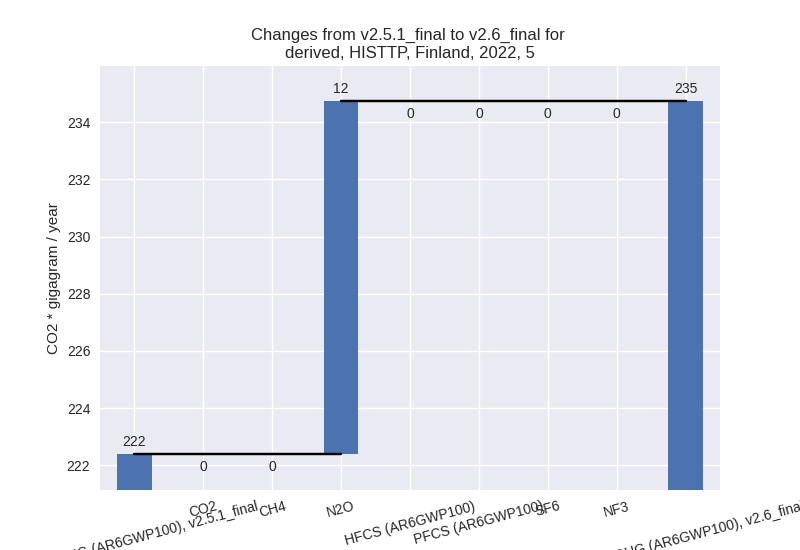Changes in PRIMAP-hist v2.6_final compared to v2.5.1_final for Finland
2024-09-24
Johannes Gütschow
Change analysis for Finland for PRIMAP-hist v2.6_final compared to v2.5.1_final
Overview over emissions by sector and gas
The following figures show the aggregate national total emissions excluding LULUCF AR6GWP100 for the country reported priority scenario. The dotted linesshow the v2.5.1_final data.
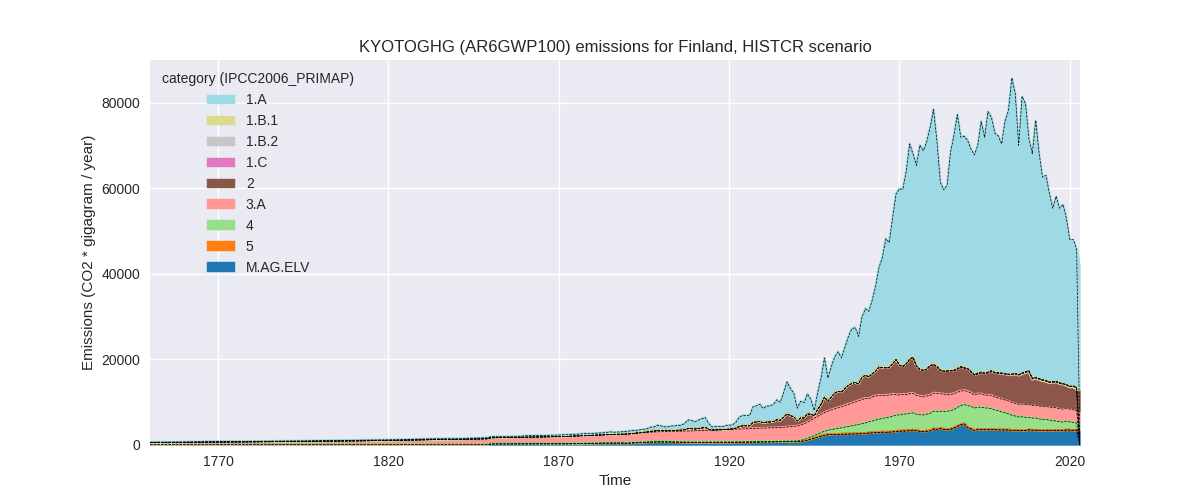
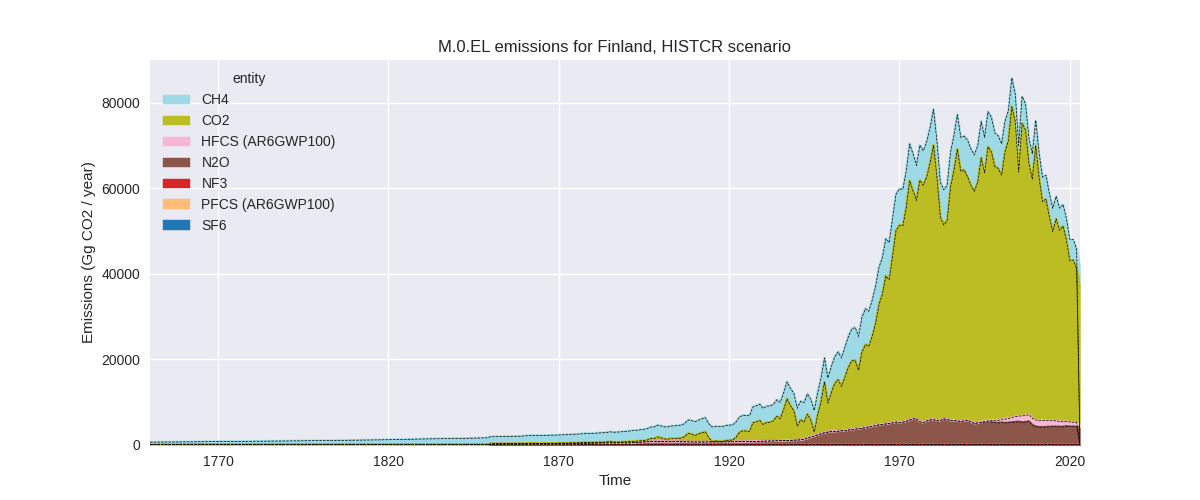
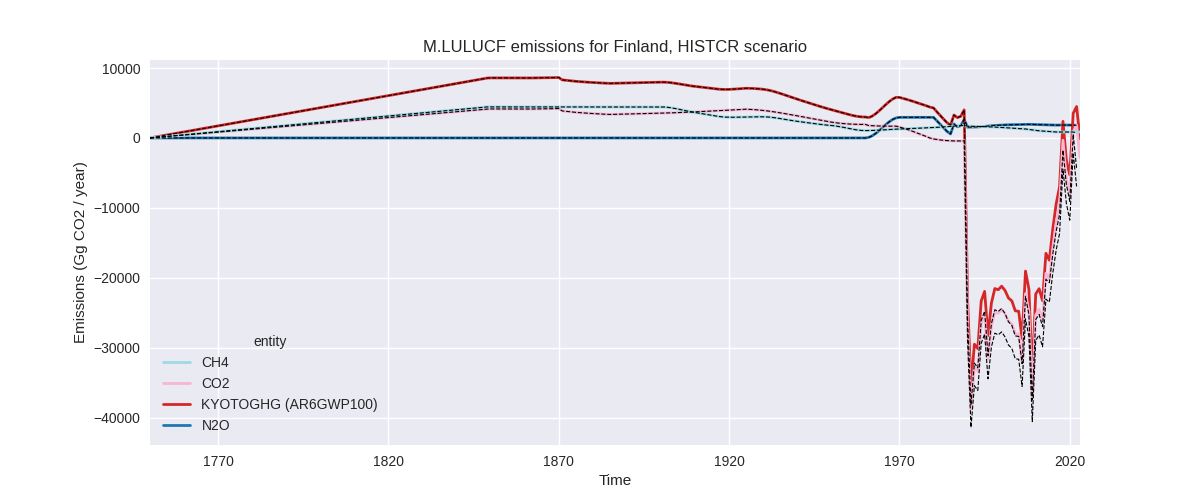
The following figures show the aggregate national total emissions excluding LULUCF AR6GWP100 for the third party priority scenario. The dotted linesshow the v2.5.1_final data.
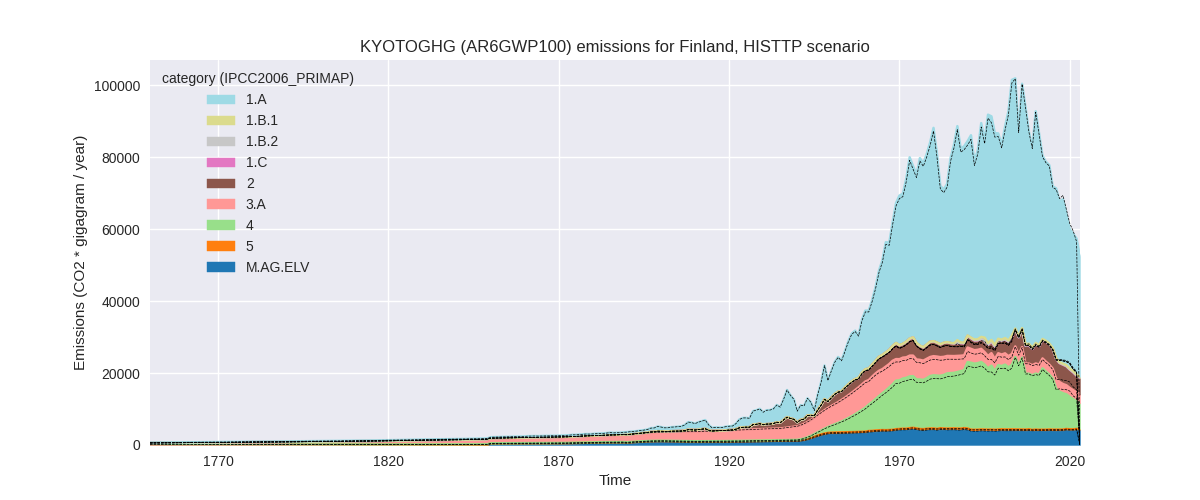
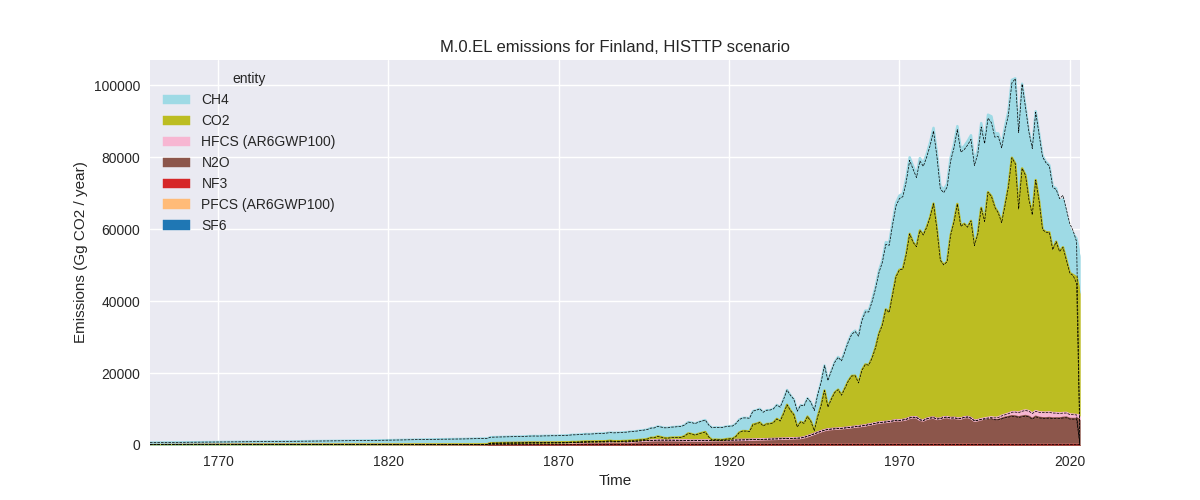
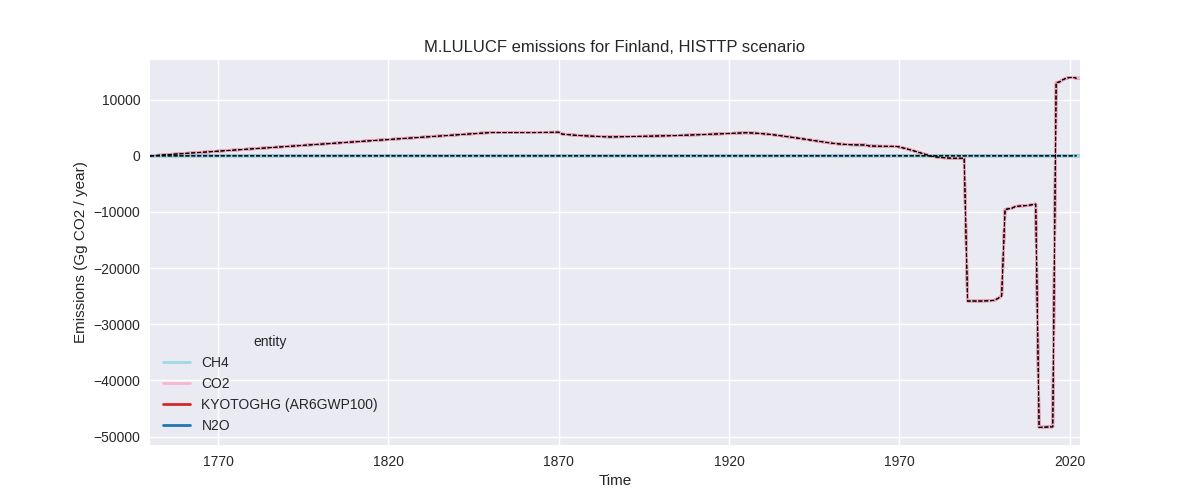
Overview over changes
In the country reported priority scenario we have the following changes for aggregate Kyoto GHG and national total emissions excluding LULUCF (M.0.EL):
- Emissions in 2022 have changed by 0.2%% (88.84 Gg CO2 / year)
- Emissions in 1990-2022 have changed by -0.1%% (-75.76 Gg CO2 / year)
In the third party priority scenario we have the following changes for aggregate Kyoto GHG and national total emissions excluding LULUCF (M.0.EL):
- Emissions in 2022 have changed by 1.5%% (849.44 Gg CO2 / year)
- Emissions in 1990-2022 have changed by 0.5%% (382.58 Gg CO2 / year)
Most important changes per scenario and time frame
In the country reported priority scenario the following sector-gas combinations have the highest absolute impact on national total KyotoGHG (AR6GWP100) emissions in 2022 (top 5):
- 1: 1.A, CO2 with 521.26 Gg CO2 / year (1.7%)
- 2: M.AG.ELV, N2O with -193.31 Gg CO2 / year (-5.8%)
- 3: 2, CO2 with -131.43 Gg CO2 / year (-3.2%)
- 4: 3.A, CH4 with -100.55 Gg CO2 / year (-3.7%)
- 5: M.AG.ELV, CO2 with 86.28 Gg CO2 / year (50.4%)
In the country reported priority scenario the following sector-gas combinations have the highest absolute impact on national total KyotoGHG (AR6GWP100) emissions in 1990-2022 (top 5):
- 1: 3.A, CH4 with -80.33 Gg CO2 / year (-2.8%)
- 2: 2, HFCS (AR6GWP100) with -16.54 Gg CO2 / year (-1.7%)
- 3: 1.A, CO2 with 9.99 Gg CO2 / year (0.0%)
- 4: M.AG.ELV, N2O with 5.70 Gg CO2 / year (0.2%)
- 5: M.AG.ELV, CO2 with 2.61 Gg CO2 / year (0.8%)
In the third party priority scenario the following sector-gas combinations have the highest absolute impact on national total KyotoGHG (AR6GWP100) emissions in 2022 (top 5):
- 1: 1.A, CO2 with 1725.95 Gg CO2 / year (5.1%)
- 2: 4, CH4 with -860.30 Gg CO2 / year (-10.3%)
- 3: 2, HFCS (AR6GWP100) with -46.16 Gg CO2 / year (-4.0%)
- 4: 4, N2O with 17.85 Gg CO2 / year (10.9%)
- 5: 5, N2O with 12.35 Gg CO2 / year (5.6%)
In the third party priority scenario the following sector-gas combinations have the highest absolute impact on national total KyotoGHG (AR6GWP100) emissions in 1990-2022 (top 5):
- 1: 4, CH4 with 308.54 Gg CO2 / year (2.0%)
- 2: 1.A, CO2 with 56.17 Gg CO2 / year (0.1%)
- 3: 4, N2O with 15.12 Gg CO2 / year (12.0%)
- 4: 5, N2O with 3.63 Gg CO2 / year (1.2%)
- 5: 2, HFCS (AR6GWP100) with -1.40 Gg CO2 / year (-0.1%)
Notes on data changes
Here we list notes explaining important emissions changes for the country. ’' means that the following text only applies to the TP time series, while means that it only applies to the CR scenario. Otherwise the note applies to both scenarios.
- We have added EEA 2024 inventory data.
- Energy CO2 emissions for 2022 are lower in both scenarios because the 2022 growth rates are smaller in EEA 2024 and EI 2024 than in EI 2023.
- N2O from M.AG.ELV is slower in 2022 (CR) because EEA 2024 shows an emissions decline while EDGAR shows an increase.
- Cement CO2 is lower in 2022 due to a decline in emissions not modeled by the Andrew cement data used in v2.5.1 (CR)
Changes by sector and gas
For each scenario and time frame the changes are displayed for all individual sectors and all individual gases. In the sector plot we use aggregate Kyoto GHGs in AR6GWP100. In the gas plot we usenational total emissions without LULUCF. ## country reported scenario
2022


1990-2022
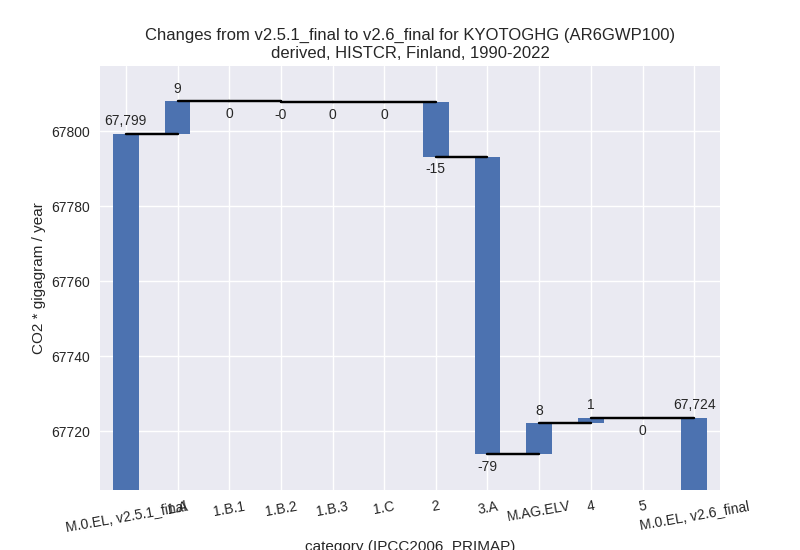
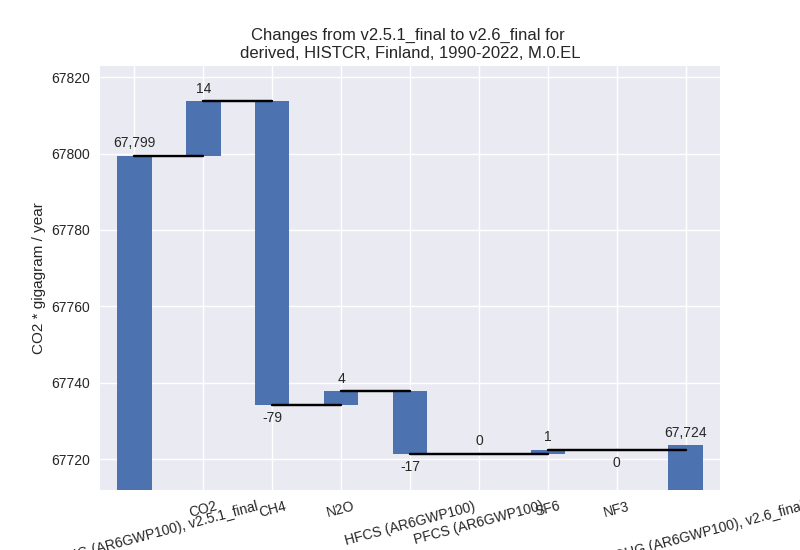
third party scenario
2022
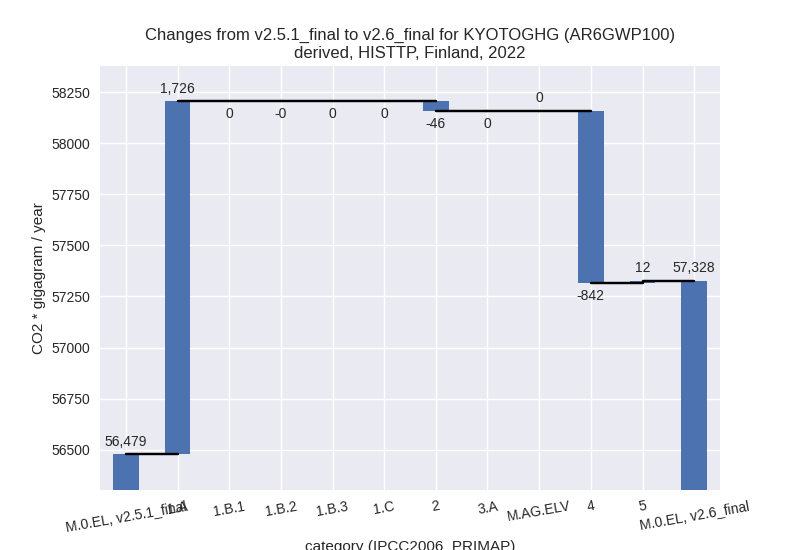
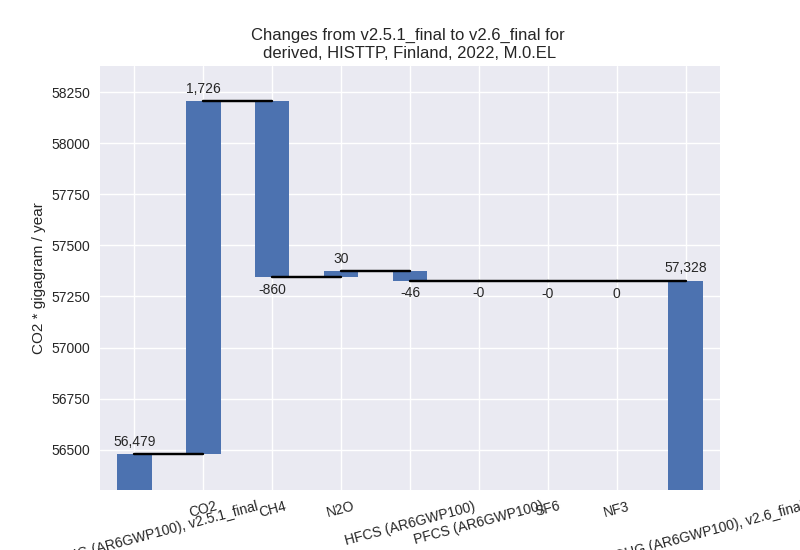
1990-2022
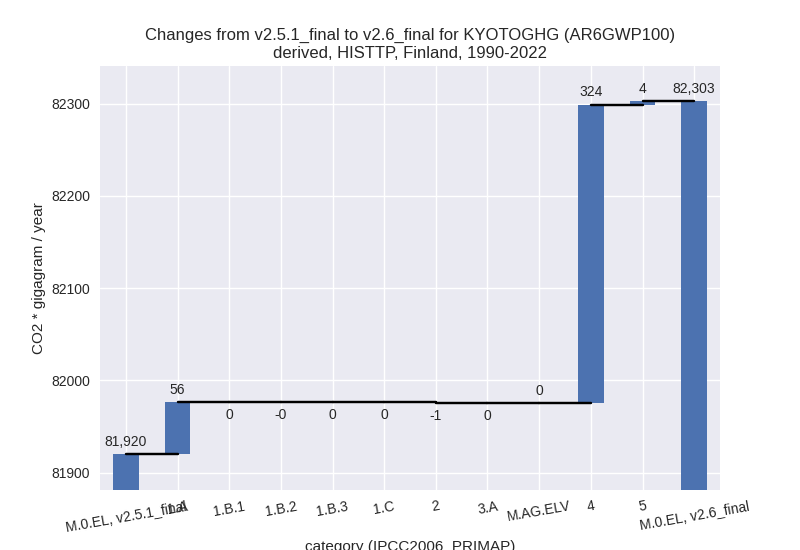
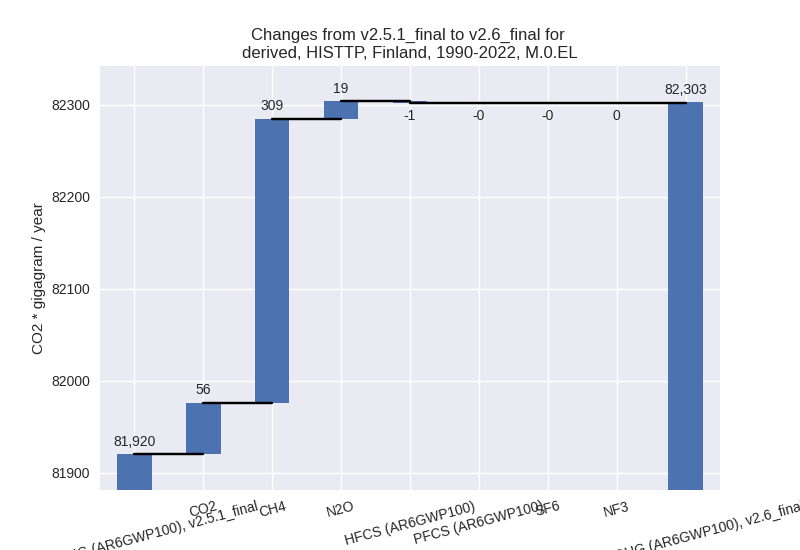
Detailed changes for the scenarios:
country reported scenario (HISTCR):
Most important changes per time frame
For 2022 the following sector-gas combinations have the highest absolute impact on national total KyotoGHG (AR6GWP100) emissions in 2022 (top 5):
- 1: 1.A, CO2 with 521.26 Gg CO2 / year (1.7%)
- 2: M.AG.ELV, N2O with -193.31 Gg CO2 / year (-5.8%)
- 3: 2, CO2 with -131.43 Gg CO2 / year (-3.2%)
- 4: 3.A, CH4 with -100.55 Gg CO2 / year (-3.7%)
- 5: M.AG.ELV, CO2 with 86.28 Gg CO2 / year (50.4%)
For 1990-2022 the following sector-gas combinations have the highest absolute impact on national total KyotoGHG (AR6GWP100) emissions in 1990-2022 (top 5):
- 1: 3.A, CH4 with -80.33 Gg CO2 / year (-2.8%)
- 2: 2, HFCS (AR6GWP100) with -16.54 Gg CO2 / year (-1.7%)
- 3: 1.A, CO2 with 9.99 Gg CO2 / year (0.0%)
- 4: M.AG.ELV, N2O with 5.70 Gg CO2 / year (0.2%)
- 5: M.AG.ELV, CO2 with 2.61 Gg CO2 / year (0.8%)
Changes in the main sectors for aggregate KyotoGHG (AR6GWP100) are
- 1: Total sectoral emissions in 2022 are 32881.57 Gg CO2 / year which is 71.7% of M.0.EL emissions. 2022 Emissions have changed by 1.5% (472.09 Gg CO2 / year). 1990-2022 Emissions have changed by 0.0% (8.56 Gg CO2 / year).
- 2: Total sectoral emissions in 2022 are 5116.33 Gg
CO2 / year which is 11.2% of M.0.EL emissions. 2022 Emissions have
changed by -4.3% (-227.67 Gg CO2 /
year). 1990-2022 Emissions have changed by -0.2% (-14.64 Gg CO2 / year). For 2022 the
changes per gas
are:
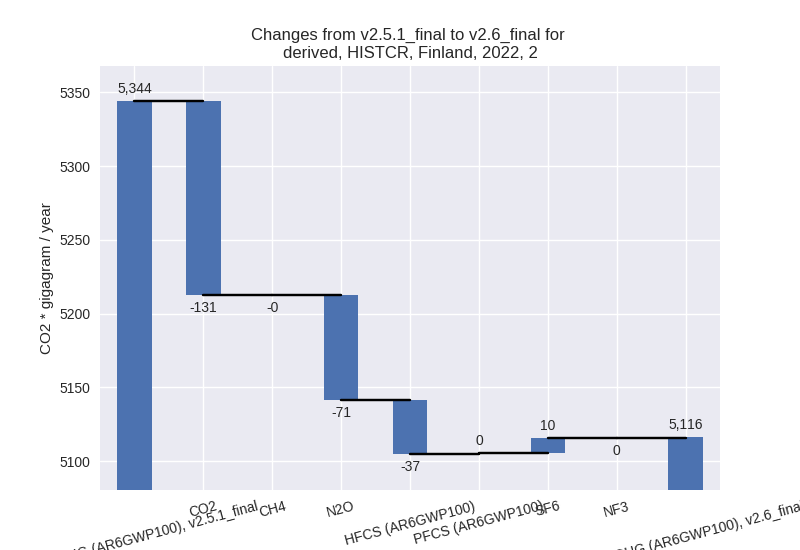
- M.AG: Total sectoral emissions in 2022 are 6161.80
Gg CO2 / year which is 13.4% of M.0.EL emissions. 2022 Emissions have
changed by -3.3% (-213.02 Gg CO2 /
year). 1990-2022 Emissions have changed by -1.1% (-71.12 Gg CO2 / year). For 2022 the
changes per gas
are:
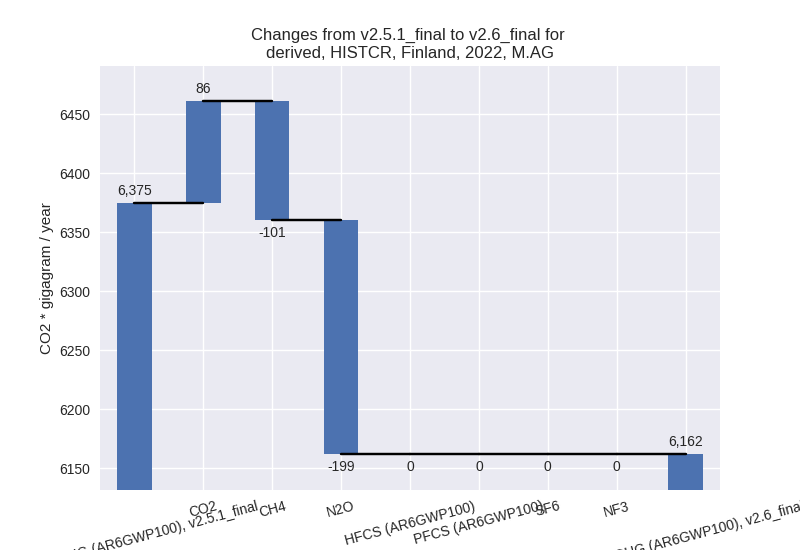
The changes come from the following subsectors:- 3.A: Total sectoral emissions in 2022 are 2783.39
Gg CO2 / year which is 45.2% of category M.AG emissions. 2022 Emissions
have changed by -3.7% (-105.99 Gg
CO2 / year). 1990-2022 Emissions have changed by -2.6% (-79.43 Gg CO2 / year). For 2022 the
changes per gas
are:
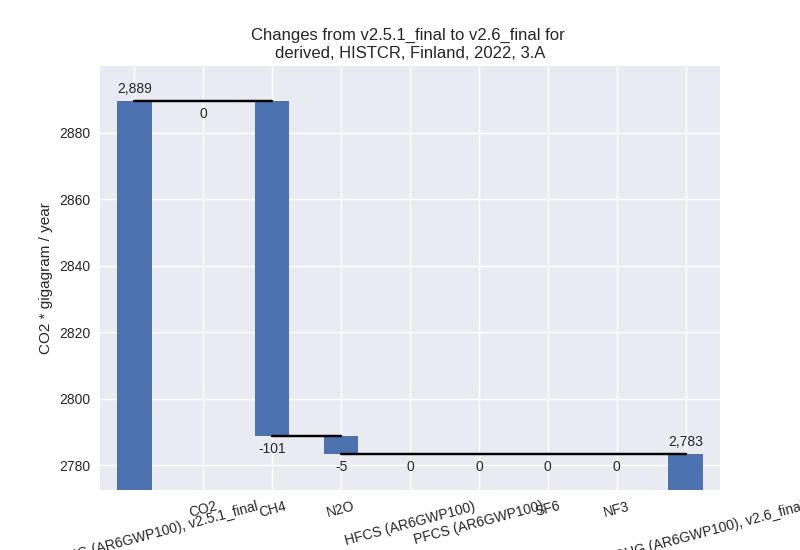
For 1990-2022 the changes per gas are: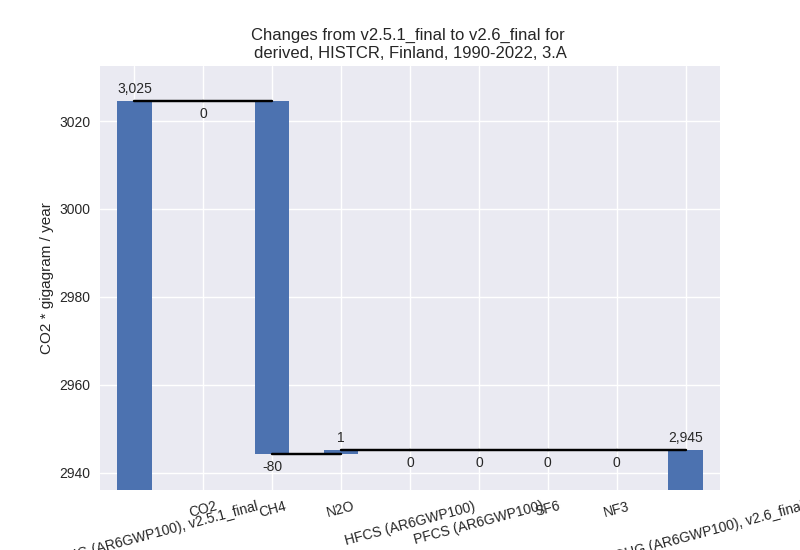
There is no subsector information available in PRIMAP-hist. - M.AG.ELV: Total sectoral emissions in 2022 are
3378.41 Gg CO2 / year which is 54.8% of category M.AG emissions. 2022
Emissions have changed by -3.1%
(-107.02 Gg CO2 / year). 1990-2022 Emissions have changed by 0.2% (8.31 Gg CO2 / year). For 2022 the
changes per gas
are:
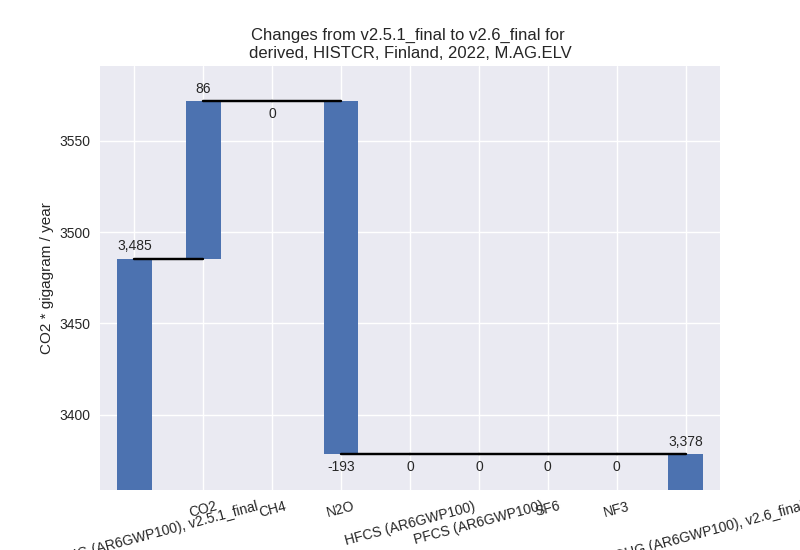
There is no subsector information available in PRIMAP-hist.
- 3.A: Total sectoral emissions in 2022 are 2783.39
Gg CO2 / year which is 45.2% of category M.AG emissions. 2022 Emissions
have changed by -3.7% (-105.99 Gg
CO2 / year). 1990-2022 Emissions have changed by -2.6% (-79.43 Gg CO2 / year). For 2022 the
changes per gas
are:
- 4: Total sectoral emissions in 2022 are 1723.66 Gg
CO2 / year which is 3.8% of M.0.EL emissions. 2022 Emissions have
changed by 3.4% (57.44 Gg CO2 /
year). 1990-2022 Emissions have changed by 0.0% (1.43 Gg CO2 / year). For 2022 the
changes per gas
are:
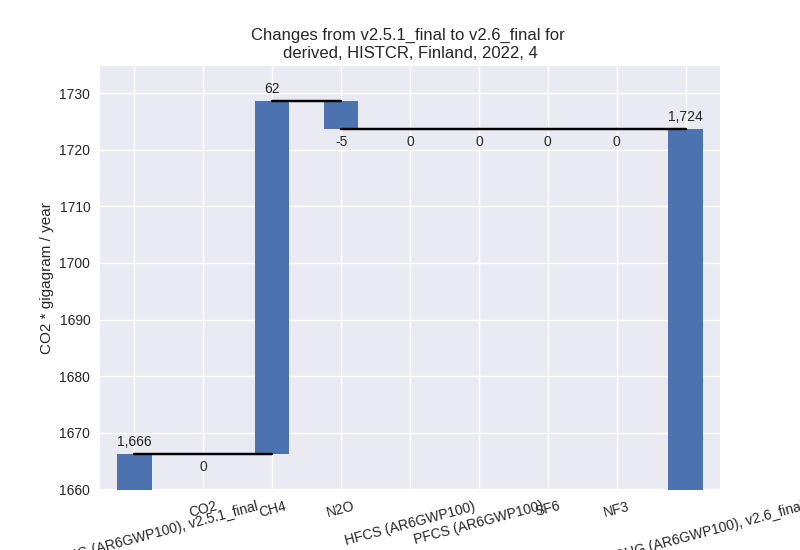
- 5: No data
third party scenario (HISTTP):
Most important changes per time frame
For 2022 the following sector-gas combinations have the highest absolute impact on national total KyotoGHG (AR6GWP100) emissions in 2022 (top 5):
- 1: 1.A, CO2 with 1725.95 Gg CO2 / year (5.1%)
- 2: 4, CH4 with -860.30 Gg CO2 / year (-10.3%)
- 3: 2, HFCS (AR6GWP100) with -46.16 Gg CO2 / year (-4.0%)
- 4: 4, N2O with 17.85 Gg CO2 / year (10.9%)
- 5: 5, N2O with 12.35 Gg CO2 / year (5.6%)
For 1990-2022 the following sector-gas combinations have the highest absolute impact on national total KyotoGHG (AR6GWP100) emissions in 1990-2022 (top 5):
- 1: 4, CH4 with 308.54 Gg CO2 / year (2.0%)
- 2: 1.A, CO2 with 56.17 Gg CO2 / year (0.1%)
- 3: 4, N2O with 15.12 Gg CO2 / year (12.0%)
- 4: 5, N2O with 3.63 Gg CO2 / year (1.2%)
- 5: 2, HFCS (AR6GWP100) with -1.40 Gg CO2 / year (-0.1%)
Changes in the main sectors for aggregate KyotoGHG (AR6GWP100) are
- 1: Total sectoral emissions in 2022 are 38077.97 Gg
CO2 / year which is 66.4% of M.0.EL emissions. 2022 Emissions have
changed by 4.7% (1725.73 Gg CO2 /
year). 1990-2022 Emissions have changed by 0.1% (56.17 Gg CO2 / year). For 2022 the
changes per gas
are:
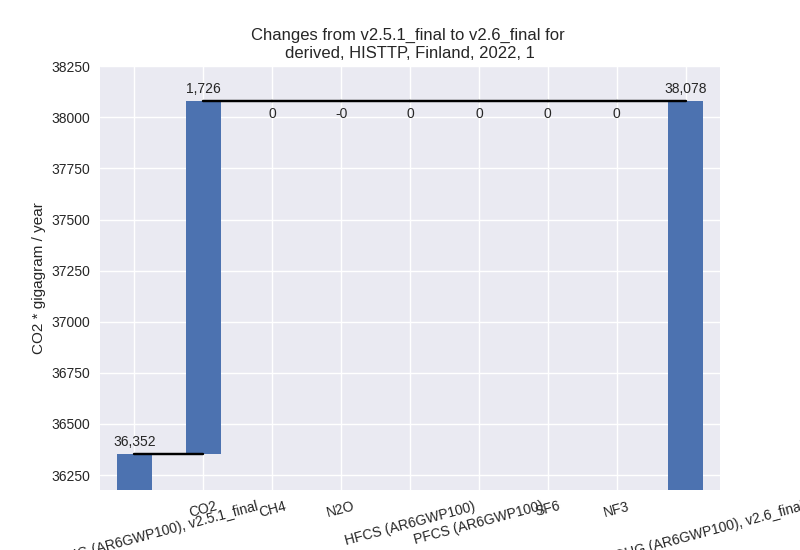
The changes come from the following subsectors:- 1.A: Total sectoral emissions in 2022 are 37728.76
Gg CO2 / year which is 99.1% of category 1 emissions. 2022 Emissions
have changed by 4.8% (1725.95 Gg CO2
/ year). 1990-2022 Emissions have changed by 0.1% (56.17 Gg CO2 / year). For 2022 the
changes per gas
are:
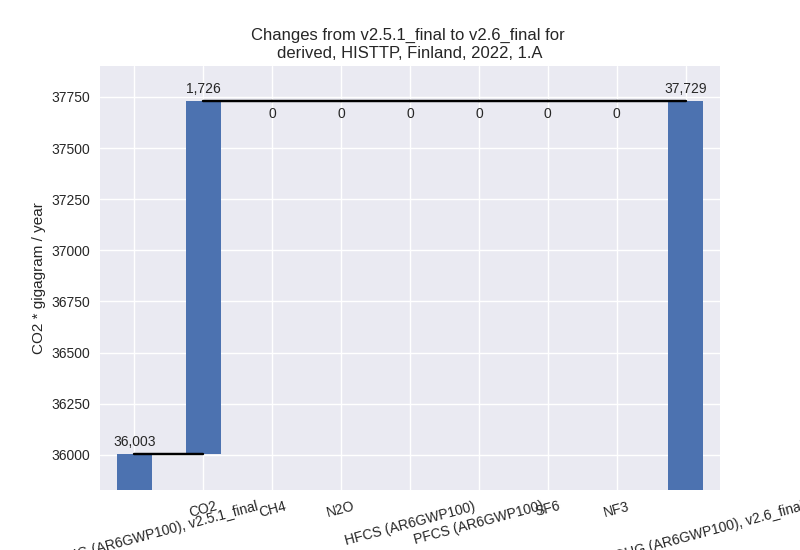
There is no subsector information available in PRIMAP-hist. - 1.B.1: Total sectoral emissions in 2022 are 266.27 Gg CO2 / year which is 0.7% of category 1 emissions. 2022 Emissions have changed by 0.0% (0.00 Gg CO2 / year). 1990-2022 Emissions have changed by 0.0% (0.00 Gg CO2 / year).
- 1.B.2: Total sectoral emissions in 2022 are 82.94 Gg CO2 / year which is 0.2% of category 1 emissions. 2022 Emissions have changed by -0.3% (-0.22 Gg CO2 / year). 1990-2022 Emissions have changed by -0.0% (-0.01 Gg CO2 / year).
- 1.A: Total sectoral emissions in 2022 are 37728.76
Gg CO2 / year which is 99.1% of category 1 emissions. 2022 Emissions
have changed by 4.8% (1725.95 Gg CO2
/ year). 1990-2022 Emissions have changed by 0.1% (56.17 Gg CO2 / year). For 2022 the
changes per gas
are:
- 2: Total sectoral emissions in 2022 are 4689.48 Gg CO2 / year which is 8.2% of M.0.EL emissions. 2022 Emissions have changed by -1.0% (-46.21 Gg CO2 / year). 1990-2022 Emissions have changed by -0.0% (-0.87 Gg CO2 / year).
- M.AG: Total sectoral emissions in 2022 are 6667.37 Gg CO2 / year which is 11.6% of M.0.EL emissions. 2022 Emissions have changed by 0.0% (0.02 Gg CO2 / year). 1990-2022 Emissions have changed by 0.0% (0.00 Gg CO2 / year).
- 4: Total sectoral emissions in 2022 are 7658.57 Gg
CO2 / year which is 13.4% of M.0.EL emissions. 2022 Emissions have
changed by -9.9% (-842.45 Gg CO2 /
year). 1990-2022 Emissions have changed by 2.1% (323.65 Gg CO2 / year). For 2022 the
changes per gas
are:
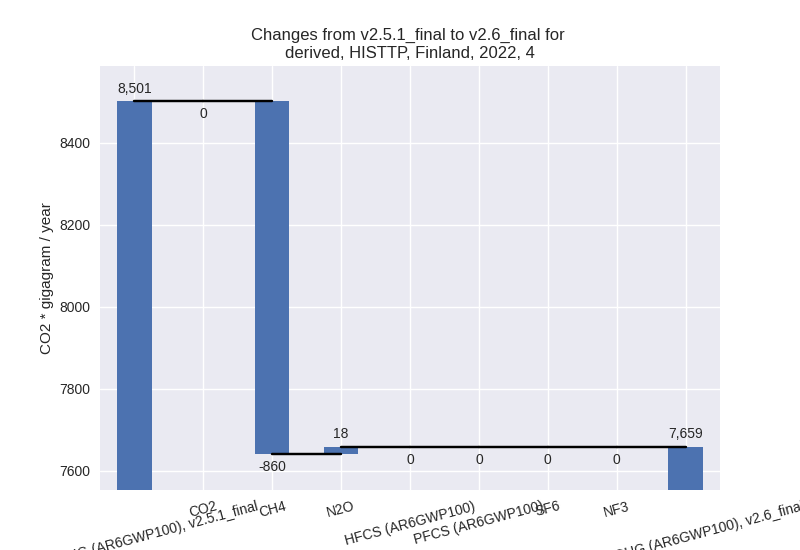
For 1990-2022 the changes per gas are: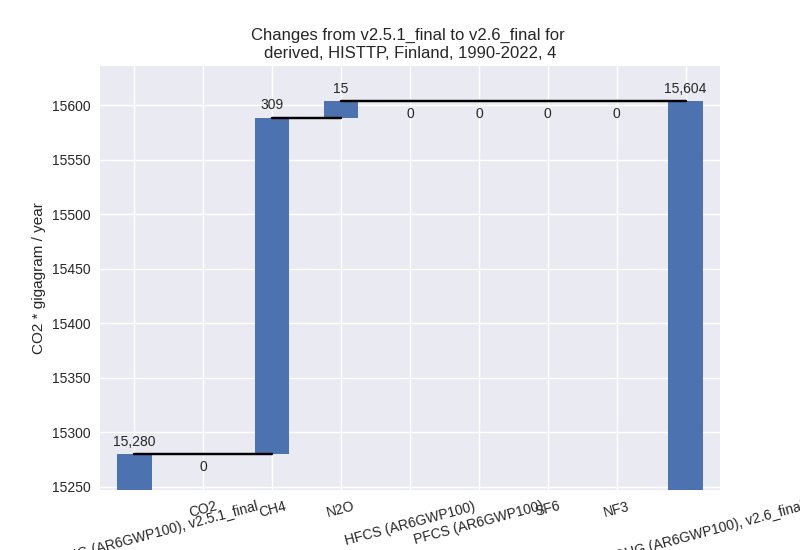
- 5: Total sectoral emissions in 2022 are 234.74 Gg
CO2 / year which is 0.4% of M.0.EL emissions. 2022 Emissions have
changed by 5.6% (12.35 Gg CO2 /
year). 1990-2022 Emissions have changed by 1.2% (3.63 Gg CO2 / year). For 2022 the
changes per gas
are:
